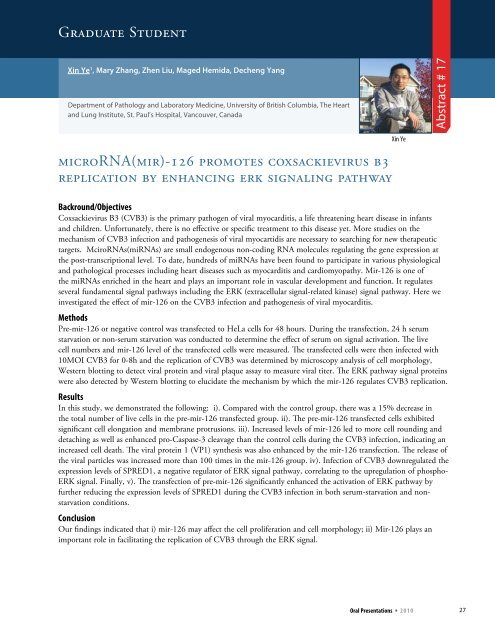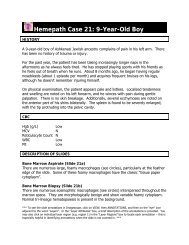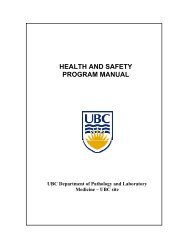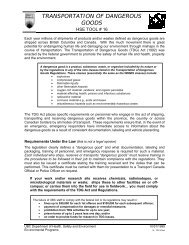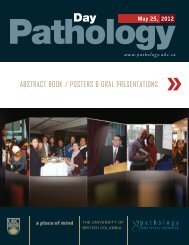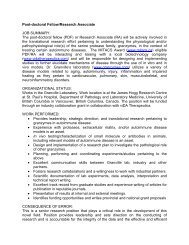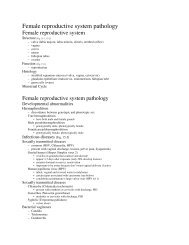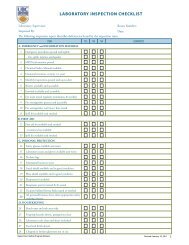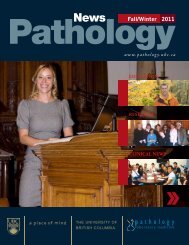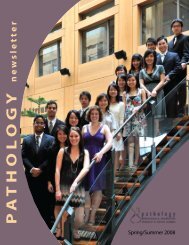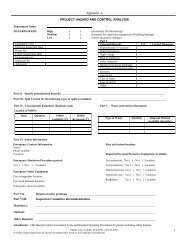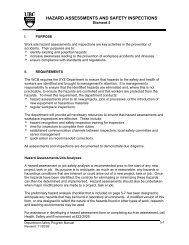Graduate StudentAbstract # 16Farshid S. Garmaroudi 1 , David Marchant 1 , Ali Bashashati 2 , Raymond T. Ng 1, 3 ,Kevin P. Murphy 3, 4 , Honglin Luo 1 , Kevin A. Janes 5 <strong>and</strong> Bruce M. McManus 11Department of <strong>Pathology</strong> <strong>and</strong> <strong>Laboratory</strong> <strong>Medicine</strong>, 2 Terry Fox <strong>Laboratory</strong>, 3 Departments ofComputer Science <strong>and</strong> 4 Statistics, 5 <strong>University</strong> of British Columbia, Canada, <strong>and</strong> Departmentof Biomedical Engineering, <strong>University</strong> of VirginiaFarshid S. Garmaroudideconstruction of the coxsackievirus b3-inducedsignaling network in cardiomyocytesBackround/ObjectivesViral myocarditis caused by virus infection of the heart muscle is a common cause of heart damage <strong>and</strong> failure.Coxsackievirus B3 (CVB3) is one of the primary causative agents of viral myocarditis, particularly in children <strong>and</strong>young adults. To date, there is neither a vaccine to prevent viral infection nor a curative treatment beyond hearttransplantation for viral myocarditis. Host cell-signaling molecules that support viral replication are potential drugtargets for preventing CVB3 infection. Our laboratory has previously identified a collection of host cell-signalingmolecules that individually contribute to CVB3 replication. Yet, it is unclear how this network of host factors isexploited by CVB3 during infection <strong>and</strong> virus propagation. Here, we propose a data-driven systems approach thatdeconstructs virus-induced host cell signaling into context-dependent molecule pairs that are mechanistically involvedin CVB3 pathogenesis.MethodsTo study the CVB3-induced network, we generated a 3-dimensional dataset: i) variables: nine signaling molecules <strong>and</strong>two virus replication indicators; ii) timepoints: sham-infected cells [0 h post-infection (p.i.)], virus-receptor interaction(0.17 h p.i.), internalization (1 h p.i.), viral RNA synthesis (8 h p.i.), viral protein synthesis (16 h pi) <strong>and</strong> virionprogeny release (24 h pi), <strong>and</strong> iii) 23 experimental conditions: (either one control, seven single signaling inhibitors orfifteen combinations of two signaling inhibitors). We used hierarchical clustering <strong>and</strong> graphical Gaussian modeling toidentify time-dependent <strong>and</strong> global pairwise relationships between measured variables in the dataset.ResultsWe predict from our analysis that: i) different mitogen activated protein kinases (MAPKs) play time-dependentroles in phosphorylating the activating transcription factor-2 (ATF2) <strong>and</strong> cAMP response element binding (CREB)transcription factors in the context of CVB3 infection; ii) inhibitor of NF-kappaB alpha protein (IkBa) plays a hubsignaling role in assembling the overall network structure. In testing our prediction involving IB, we show thatBAY11-7085 (a selective inhibitor of NF-kB downstream of IB) significantly reduces virus protein synthesis <strong>and</strong> viralprogeny release.ConclusionApparently, kinases are potentially targetable in viral myocarditis. To define a systems-level structure of signalingcomponents may enable us to propose a more effective target (fewer side-effects) in treatment of the disease. This workshows how CVB3 infection is a host signaling network perturbation that can be simplified in a pairwise fashion toidentify groups of molecules that are interrelated.26 2 0 1 0 * O r a l P r e s e n t a t i o n s
Graduate StudentXin Ye 1 , Mary Zhang, Zhen Liu, Maged Hemida, Decheng YangDepartment of <strong>Pathology</strong> <strong>and</strong> <strong>Laboratory</strong> <strong>Medicine</strong>, <strong>University</strong> of British Columbia, The Heart<strong>and</strong> Lung Institute, St. Paul’s Hospital, Vancouver, CanadaAbstract # 17microRNA(mir)-126 promotes coxsackievirus b3replication by enhancing erk signaling pathwayXin YeBackround/ObjectivesCoxsackievirus B3 (CVB3) is the primary pathogen of viral myocarditis, a life threatening heart disease in infants<strong>and</strong> children. Unfortunately, there is no effective or specific treatment to this disease yet. More studies on themechanism of CVB3 infection <strong>and</strong> pathogenesis of viral myocartidis are necessary to searching for new therapeutictargets. MciroRNAs(miRNAs) are small endogenous non-coding RNA molecules regulating the gene expression atthe post-transcriptional level. To date, hundreds of miRNAs have been found to participate in various physiological<strong>and</strong> pathological processes including heart diseases such as myocarditis <strong>and</strong> cardiomyopathy. Mir-126 is one ofthe miRNAs enriched in the heart <strong>and</strong> plays an important role in vascular development <strong>and</strong> function. It regulatesseveral fundamental signal pathways including the ERK (extracellular signal-related kinase) signal pathway. Here weinvestigated the effect of mir-126 on the CVB3 infection <strong>and</strong> pathogenesis of viral myocarditis.MethodsPre-mir-126 or negative control was transfected to HeLa cells for 48 hours. During the transfection, 24 h serumstarvation or non-serum starvation was conducted to determine the effect of serum on signal activation. The livecell numbers <strong>and</strong> mir-126 level of the transfected cells were measured. The transfected cells were then infected with10MOI CVB3 for 0-8h <strong>and</strong> the replication of CVB3 was determined by microscopy analysis of cell morphology,Western blotting to detect viral protein <strong>and</strong> viral plaque assay to measure viral titer. The ERK pathway signal proteinswere also detected by Western blotting to elucidate the mechanism by which the mir-126 regulates CVB3 replication.ResultsIn this study, we demonstrated the following: i). Compared with the control group, there was a 15% decrease inthe total number of live cells in the pre-mir-126 transfected group. ii). The pre-mir-126 transfected cells exhibitedsignificant cell elongation <strong>and</strong> membrane protrusions. iii). Increased levels of mir-126 led to more cell rounding <strong>and</strong>detaching as well as enhanced pro-Caspase-3 cleavage than the control cells during the CVB3 infection, indicating anincreased cell death. The viral protein 1 (VP1) synthesis was also enhanced by the mir-126 transfection. The release ofthe viral particles was increased more than 100 times in the mir-126 group. iv). Infection of CVB3 downregulated theexpression levels of SPRED1, a negative regulator of ERK signal pathway, correlating to the upregulation of phospho-ERK signal. Finally, v). The transfection of pre-mir-126 significantly enhanced the activation of ERK pathway byfurther reducing the expression levels of SPRED1 during the CVB3 infection in both serum-starvation <strong>and</strong> nonstarvationconditions.ConclusionOur findings indicated that i) mir-126 may affect the cell proliferation <strong>and</strong> cell morphology; ii) Mir-126 plays animportant role in facilitating the replication of CVB3 through the ERK signal.<strong>Oral</strong> <strong>Presentations</strong> * 2 0 1 027
- Page 2: PathDay: Keynote Speaker (4:30 pm)T
- Page 5: Conference Outline2010abstract #14
- Page 9 and 10: Table of Contentabstract #57 The ro
- Page 11 and 12: ResidentClinical SciencesArwa Al-Ri
- Page 13 and 14: ResidentTitus Wong 1 , Marc Romney,
- Page 17 and 18: ResidentD. Turbin 1 , D. Gao 2 , J.
- Page 19 and 20: ResidentDavid F Schaeffer 1 , Eric
- Page 21 and 22: ResidentMajid Zolein 1 , Daniel T.
- Page 23 and 24: Graduate StudentAshish K. Marwaha 1
- Page 25: Graduate StudentAmanda Vanden Hoek
- Page 29: Graduate StudentLisa S. Ang 1 , Sar
- Page 32 and 33: Graduate StudentAbstract # 22Brian
- Page 36 and 37: OtherAbstract # 25Crystal Leung, Li
- Page 38 and 39: OtherAbstract # 27Lise Matzke 1 , W
- Page 40 and 41: Graduate StudentAbstract # 29Varun
- Page 42 and 43: Graduate StudentAbstract # 31Maite
- Page 44 and 45: Post-doctoral FellowAbstract # 33Ra
- Page 46 and 47: Graduate StudentAbstract # 35Hayley
- Page 48: Post-doctoral FellowAbstract # 37Es
- Page 51 and 52: ResidentAhmad Al-Sarraf MD 1, 2 , G
- Page 53 and 54: OtherRebecca Towle 1 , Danielle Mac
- Page 55 and 56: Graduate StudentPaul R. Hiebert 1,2
- Page 57 and 58: Graduate StudentV. Montoya 1 , J. G
- Page 59 and 60: OtherWalter Martz and Henry Kalicia
- Page 61 and 62: OtherKatelyn J. Janzen 1 , Elizabet
- Page 63 and 64: Graduate StudentJasmine L. Hamilton
- Page 65 and 66: Graduate StudentIan M. Wilson 1 , K
- Page 67 and 68: Graduate StudentKelsie L. Thu 1,3 ,
- Page 69 and 70: OtherLiat Apel-Sarid 1 , Doug Cochr
- Page 71 and 72: Graduate StudentJennifer R. Choo 1,
- Page 73 and 74: Graduate StudentEdwin S. Gershom 1
- Page 75 and 76: OtherYing Qiao 1, 2 , Chansonette H
- Page 77 and 78:
Graduate StudentLeslie YM Chin 1,4
- Page 79 and 80:
Graduate StudentBillie Velapatiño
- Page 81 and 82:
Graduate StudentSophie Stukas 1 , S
- Page 83 and 84:
Graduate StudentKyluik DL and Scott
- Page 85 and 86:
Post-doctoral FellowJoel Montane 1
- Page 87 and 88:
IndexAAbozina A. 45Abraham T. 55All
- Page 89:
Ye X. 27, 82Yee S. 31Yoshida E. 12Y


